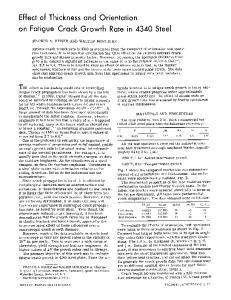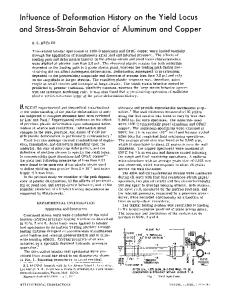Effect of Copper Film Thickness on Stress and Strain in Grains of Different Orientation
- PDF / 438,846 Bytes
- 6 Pages / 414.72 x 648 pts Page_size
- 55 Downloads / 357 Views
often exists [3]. The difference in stress state between grains of different orientation in films of mixed texture has been shown to preferentially influence the growth of certain grains [2], a process known to be detrimental to electromigration resistance in aluminum [4, 5]. Furthermore, hillock growth in aluminum films has also been attributed to stress differences in a film of imperfect texture [5], and this phenomenon may also appear in copper films. Thus, it is important to understand the stress states of not only grains corresponding to the primary texture of a film, but also of randomly oriented grains or grains corresponding to a secondary texture. Flow Stresses in Thin Films A strong inverse relationship between flow stress and film thickness has been identified for many metallic thin films, and this phenomenon has been reported in Cu thin films as well [6]. Several models have been proposed which explain high thin film flow stresses and the inverse thickness effect in terms of the stress required for dislocation glide in the constraining presence of film/substrate and film/surface layer interfaces. In order for flow by dislocation glide to occur, the work done by the stress in the film must also be sufficient to deposit interfacial dislocations. One such model, developed by Nix [7], describes the flow stress in a film as: sin b ( "f cosocosX 2n(1-v)h lf +
ln(l-h< • ,-- b
"' gtf +g. ln(° ,b-Jl(
459 Mat. Res. Soc. Symp. Proc. Vol. 356 ©1995 Materials Research Society
()
where b is the Burgers vector, h is the film thickness, t is the oxide thickness, 1sf, gs, and go are the elastic shear moduli of a film, substrate, and oxide layer, respectively, and P3sand P3o are constants. If no oxide or passivation layer is present, as is the case for bare Cu, then the second term in the parentheses is omitted. The film orientation is reflected in two terms which contain the angles 0 and X,the angles between the film normal and the glide plane normal and Burgers vector, respectively. The Schmid factor term, cosocosk, determines the shear stress necessary to move a dislocation on a certain glide plane, and the dislocation length term, sino, when divided by the film thickness, gives the length of the moving dislocation spanning the distance between the top and bottom film interfaces along the glide plane. Using the constants RlCu= 4 6 GPa, IJtsi= 66 . 5 GPa, b=2.56 A, v=0.33, and sino/cos4cosk=3.464, the thickness dependent flow stress of a {1I I I textured copper film at room temperature may be estimated. For a {100) textured film the geometric term becomes sino/cosocosX-2.0. Another significant contributor to the high strength of thin films is the typically fine
microstructure. It is therefore common to add a grain size strengthening term, often in the form of the Hall-Petch relation [8], to the flow stress expression for fine grained films at low temperatures, for which this effect is significant. The total flow stress is the sum of the two mechanisms: (Yflowtotal
= (Tflow + kcud-2
(2)
where d is median grain
Data Loading...











